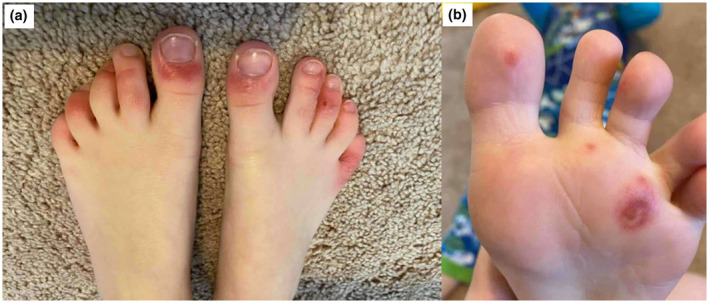Dear Editor,
Multiple cutaneous manifestations of coronavirus 19 (COVID‐19) have been described but with limited knowledge of timeline and often absence of coronavirus PCR and/or serologic testing. With the current COVID‐19 pandemic, there has been increased utilization of telehealth visits, which can allow for rapid multispecialty evaluation in a safe environment. We demonstrate optimized use of telehealth visits and share a unique delayed cutaneous manifestation of COVID‐19, confirmed by serologic testing.
A 7‐year‐old male was evaluated twice for concerns regarding the feet. These visits were performed as video telehealth encounters in the general pediatric outpatient clinic. The first telehealth visit was for right toe pain, swelling, and inability to bear weight in the setting of an injury sustained while kicking the bottom wooden section of a couch. Quality photos were sent via the online medical record system and revealed erythema and mild edema of the right dorsal toes and localized violaceous vesicular changes in the right plantar foot (Fig. 1a,b). Radiograph performed revealed no osseous abnormality. The patient was diagnosed with soft tissue changes related to trauma.
Figure 1.

(a) Erythema and mild edema of the toes; (b) localized violaceous vesicular changes
The second telehealth visit was performed because of ongoing skin changes, now involving both feet. The patient reported minimal pain and mild pruritus. The lesions visualized on video were increasingly violaceous and involved the plantar feet in addition to toes. Subsequent photos revealed chilblains‐like changes in the feet (Fig. 2a,b). There were violaceous lesions and erosions on the dorsal toes. Owing to concerns for skin manifestation of COVID‐19 or other systemic disease, a Pediatric Dermatology electronic consultation was performed.
Figure 2.

(a) Chilblains‐like violaceous changes in the dorsal toes; (b) plantar foot with violaceous macules and erosion
Pediatric Dermatology recommended additional blood work and agreed with testing for COVID‐19. Complete blood count, ESR, and comprehensive metabolic profile were unremarkable. EBV antibody profile was negative. Nasopharyngeal swab for SARS‐CoV‐2 PCR was negative. Serum SARS‐CoV‐2 IgG antibodies were positive.
Of note, the patient denied fever or respiratory symptoms. The most recent infectious symptoms occurred approximately 2 months prior when the patient was seen in the emergency department for fever, pharyngitis, and cough. Streptococcal testing and influenza testing were performed and found negative.
COVID‐19 has become a pandemic condition, and dermatologic manifestations are being increasingly described. There have been reports of transient livedo reticularis, urticarial‐like, vesicular, and dengue fever‐like eruptions, which tend to occur during infection. 1 , 2 , 3 , 4 Recently, reddish‐purple lesions on the distal fingers and toes, similar in appearance to perniosis (chilblains), have been described in patients with documented or suspected COVID‐19. 5 , 6 It has been hypothesized that these lesions could be a late manifestation of COVID‐19, supported by the fact that some of the patients reported symptoms or contact with higher‐risk individuals weeks prior to the appearance of these skin lesions but lacked serologic testing. 6 , 7 Indeed in our patient, there was a history of a febrile illness approximately 6 weeks prior to the onset of the skin lesions. The fact that our patient tested positive for COVID‐19 IgG and negative for PCR also supports the hypothesis of these chilblains‐like lesions being a delayed presentation. In future patients presenting with these types of lesions, we recommend inquiring about exposure to COVID‐19 contacts, presence of COVID‐type symptoms in weeks prior, and if possible, pursuing serological testing. Additionally, our case highlights the use of multidisciplinary virtual care aiding in the diagnosis.
As evidenced by this case as well as other reports from the literature, chilblains‐like violaceous skin lesions of acral sites can represent a delayed manifestation of COVID‐19. Antibody testing may assist with confirming prior exposure and/or aid in contact tracing. This case also demonstrates the effectiveness of telehealth to provide high‐quality multidisciplinary care while maintaining patient and staff safety.
Conflict of interest: None.
Funding source: None.
References
- 1. Recalcati S. Cutaneous manifestations in COVID‐19: a first perspective. J Eur Acad Dermatol Venereol 2020. Epub ahead of print. [DOI] [PubMed] [Google Scholar]
- 2. Manalo IF, Smith MK, Cheeley J, Jacobs R. A Dermatologic manifestation of COVID‐19: transient livedo reticularis. J Am Acad Dermatol. 2020. Epub ahead of print. [DOI] [PMC free article] [PubMed] [Google Scholar]
- 3. Marzano AV, Genovese G, Fabbrocini G, et al. Varicella‐like exanthem as a specific COVID‐19‐associated skin manifestation: multicenter case series of 22 patients. J Am Acad Dermatol. Epub ahead of print. [DOI] [PMC free article] [PubMed] [Google Scholar]
- 4. Joob B, Wiwanitkit V. COVID‐19 can present with a rash and be mistaken for dengue. J Am Acad Dermatol 2020; 82(5): e177. [DOI] [PMC free article] [PubMed] [Google Scholar]
- 5. Alramthan A, Aldaraji W. A case of COVID‐19 presenting in clinical picture resembling chilblains disease. First report from the Middle East. Clin Exp Dermatol. 2020. Epub ahead of print. [DOI] [PMC free article] [PubMed] [Google Scholar]
- 6. Landa N, Mendieta‐Eckert M, Fonda‐Pascual P, Aguirre T. Chilblain‐like lesions on feet and hands during the COVID‐19 pandemic. Int J Dermatol 2020;59(6):739–743. [DOI] [PMC free article] [PubMed] [Google Scholar]
- 7. Recalcati S, Barbagallo T, Frasin LA, et al. Acral cutaneous lesions in the time of COVID‐19. J Eur Acad Dermatol Venereol. Epub ahead of print. [DOI] [PMC free article] [PubMed] [Google Scholar]


